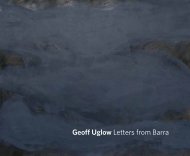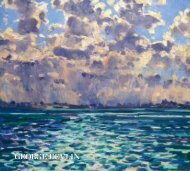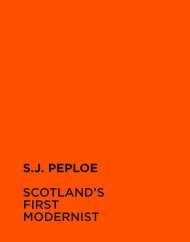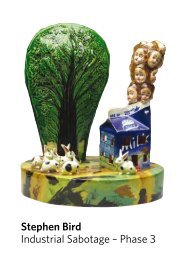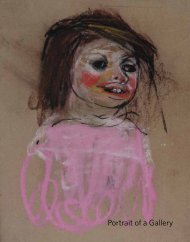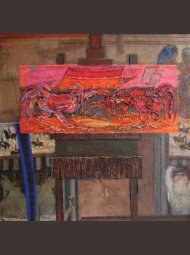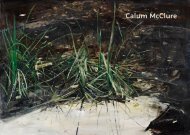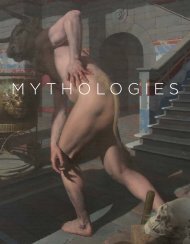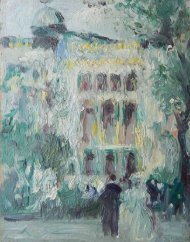Download a PDF of the exhibition catalogue - The Scottish Gallery
Download a PDF of the exhibition catalogue - The Scottish Gallery
Download a PDF of the exhibition catalogue - The Scottish Gallery
Create successful ePaper yourself
Turn your PDF publications into a flip-book with our unique Google optimized e-Paper software.
serviced by two discerning dealers: Alexander (‘Alex’) Reid, who in 1889 opened his<br />
gallery in Glasgow, La Société des Beaux-Arts; and in Edinburgh <strong>the</strong> firm <strong>of</strong> Aitken<br />
Dott. Reid, who had shared rooms with Vincent van Gogh in Paris when he was learning<br />
<strong>the</strong> trade with Vincent’s bro<strong>the</strong>r <strong>The</strong>o, was a persuasive and charismatic gallerist who<br />
established a family business which eventually left Glasgow to form Reid & Lefèvre in<br />
London, where it trades still today.<br />
Aitken Dott opened his art business in May 1842 in Edinburgh and it was his<br />
son Peter McOmish Dott who developed <strong>the</strong> business as a picture dealer by opening<br />
<strong>The</strong> <strong>Scottish</strong> <strong>Gallery</strong> in 1896. Blyth formed a stronger relationship with this firm than<br />
with any o<strong>the</strong>r dealer, and <strong>the</strong> majority <strong>of</strong> pictures acquired over his long life were<br />
bought from <strong>The</strong> <strong>Scottish</strong> <strong>Gallery</strong>. His first major purchase <strong>of</strong> a work by McTaggart, Away<br />
to <strong>the</strong> West, was from an <strong>exhibition</strong> held in <strong>the</strong> Castle Street premises in 1910, <strong>the</strong> year<br />
<strong>of</strong> <strong>the</strong> artist’s death. <strong>The</strong> first work by Peploe, Town in Brittany, was purchased in 1915<br />
from Reid’s gallery in Glasgow. Blyth was able to visit Glasgow and Edinburgh at least<br />
one or two times a week as a travelling salesman for <strong>the</strong> family firm; he visited London<br />
about twice a year. His daughter Margery remembered that ‘he would hardly ever go to<br />
London without returning with a picture or two.’<br />
Describing her fa<strong>the</strong>r as ‘extrovert and popular but contented in his own<br />
home’, Margery remembered his strong and ‘very <strong>Scottish</strong>’ emotions for music and art:<br />
‘He would weep at a touch but also be adamant.’ Lillian Browse, who supplied Blyth with<br />
a number <strong>of</strong> Sickerts in <strong>the</strong> 1940s, also used <strong>the</strong> word ‘adamant’ to describe his character.<br />
She remembered distinctly his ‘Raeburn head’, and spoke <strong>of</strong> his passion for art: ‘He used<br />
to lick his lips in front <strong>of</strong> a painting as if it were a huge feast.’ She talked <strong>of</strong> his great sense<br />
<strong>of</strong> fun and recalled that he was very ‘touchy’ about <strong>the</strong> London dealers’ attitudes to <strong>the</strong><br />
<strong>Scottish</strong> artists. Never an easy client, he was strong minded and liked to haggle over<br />
prices in order to secure bargains. Margery remembered that ‘he used to groan heavily<br />
when he had to write a cheque’.<br />
Blyth never ventured across <strong>the</strong> Channel in pursuit <strong>of</strong> pictures. He would have<br />
seen works by Degas, Manet and Cézanne at Alex Reid’s gallery in Glasgow before<br />
<strong>the</strong> Great War, but at that time was not tempted. He was never able to compete with<br />
collectors such as Burrell, who could afford to spend £6,500 on a Degas in 1926, but nor<br />
was competition with rival collectors his motivation. He had very strong and particular<br />
taste – taste which did develop. For example, he began to collect Sickert in earnest<br />
in <strong>the</strong> 1940s, but not at <strong>the</strong> expense <strong>of</strong> his advocacy for McTaggart; when McTaggart<br />
prices fell in <strong>the</strong> depressed years <strong>of</strong> <strong>the</strong> Second World War, Blyth saw opportunities for<br />
new purchases ra<strong>the</strong>r than bemoaning his lack <strong>of</strong> judgment in paying so much before.<br />
<strong>The</strong> most expensive item Blyth ever purchased was White Surf by McTaggart for £1,050<br />
in 1920 from <strong>The</strong> <strong>Scottish</strong> <strong>Gallery</strong>. W.J. Macaulay, director <strong>of</strong> <strong>The</strong> <strong>Scottish</strong> <strong>Gallery</strong> in<br />
<strong>the</strong> 1960s, recalled that Blyth actually had to sell his car in order to buy his first work<br />
by McTaggart, although this was a period <strong>of</strong> relative prosperity for Blyth. His love <strong>of</strong> a<br />
bargain may well have been <strong>the</strong> motivation for some <strong>of</strong> his purchases, and <strong>the</strong> works by<br />
Vuillard, Corot and Boudin that were added to his collection at a relatively late stage<br />
were certainly bought advantageously.<br />
As a natural extension to his interest in art he was drawn into public life and<br />
became closely identified with <strong>the</strong> development <strong>of</strong> <strong>the</strong> Kirkcaldy Art <strong>Gallery</strong>. In February<br />
1925 he was appointed <strong>the</strong> <strong>Gallery</strong>’s first convenor, a position which he occupied for <strong>the</strong><br />
rest <strong>of</strong> his life. He was made chairman <strong>of</strong> <strong>the</strong> <strong>Scottish</strong> Modern Arts Association (SMAA),<br />
an organisation set up in 1907 to buy pieces to form <strong>the</strong> nucleus <strong>of</strong> a national collection<br />
<strong>of</strong> modern work. His knowledge and his passion as a collector made him a natural choice<br />
as a trustee <strong>of</strong> <strong>the</strong> National <strong>Gallery</strong> <strong>of</strong> Scotland in 1944.<br />
4



